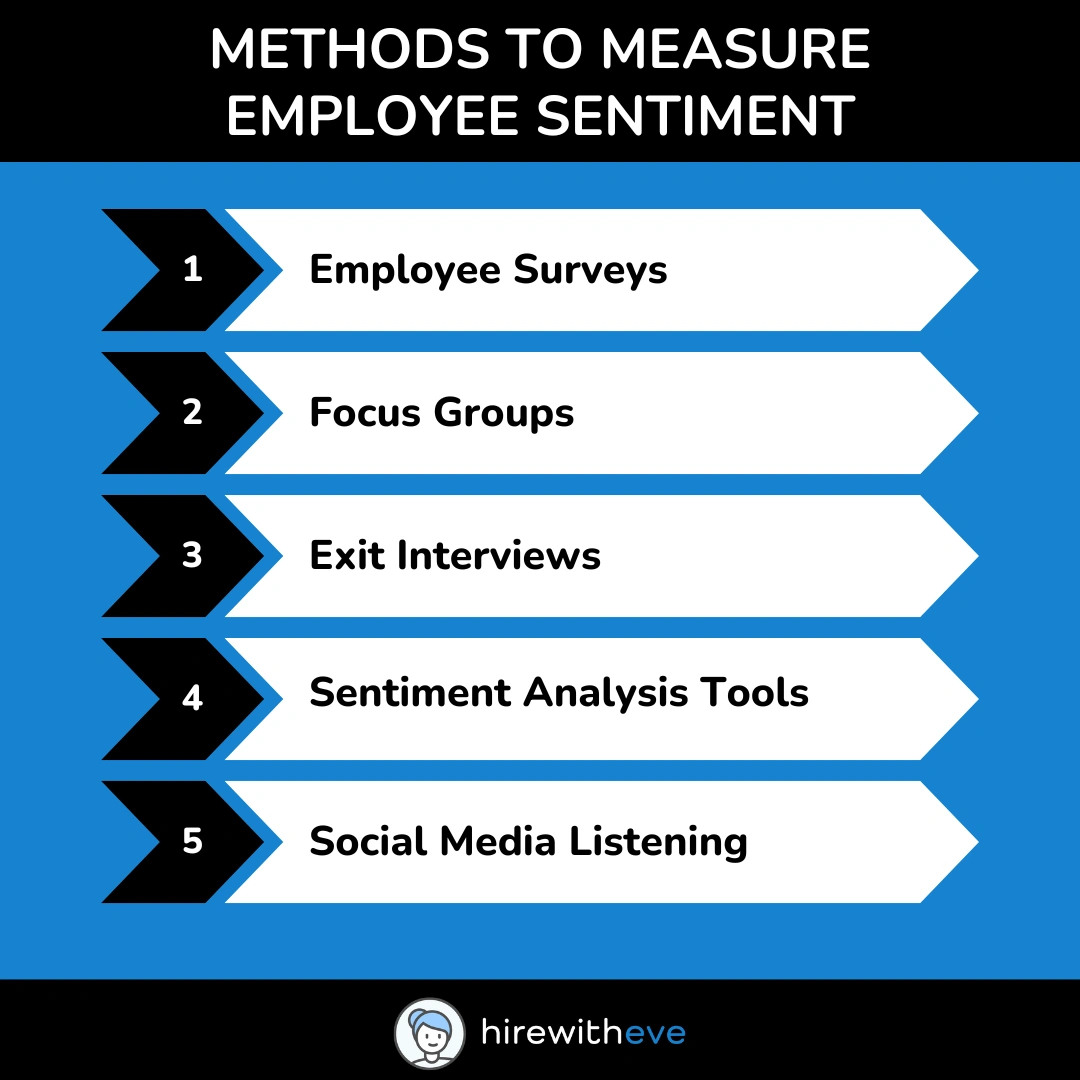What Is Employee Sentiment and How to Measure It?
What Is Employee Sentiment and How to Measure It?

In today’s fast-evolving workplace, one term that HR professionals and talent acquisition specialists cannot ignore is Employee Sentiment. As companies aim to foster inclusive, engaging, and productive work environments, understanding the feelings, attitudes, and perceptions of employees is more critical than ever.
Measuring Employee Sentiment allows organizations to gather insights into workplace culture, job satisfaction, and employee engagement, which, in turn, leads to better decision-making and talent retention strategies.
This blog will dive into what Employee Sentiment is, why it’s important, how to measure it effectively, and how platforms like HirewithEve can assist in this process.
Table of contents
Understanding Employee Sentiment
At its core, Employee Sentiment refers to the collective emotions, opinions, and attitudes employees have toward their work, colleagues, and company. It encompasses various aspects of the employee experience, including engagement levels, satisfaction with leadership, perceptions of company culture, and general morale.
Measuring Employee Sentiment offers companies a window into how their employees feel about their day-to-day work lives. This data can reveal hidden issues, areas for improvement, or success stories that leadership can amplify.
When companies understand their employees' sentiments, they can proactively address concerns, thereby reducing turnover, enhancing productivity, and building a positive work environment.
Why Employee Sentiment Matters?
The importance of Employee Sentiment cannot be overstated. A workforce that feels heard, valued, and engaged is more likely to be productive and stay loyal to the organization.
Here are some key reasons why tracking Employee Sentiment should be a priority:
Boosts Employee Engagement: High levels of Employee Sentiment correlate directly with increased employee engagement. Engaged employees tend to contribute more, exhibit higher levels of creativity, and take ownership of their work.
Improves Retention Rates: Employees who feel positive about their work environment and leadership are less likely to seek opportunities elsewhere. Understanding Employee Sentiment can help HR professionals identify at-risk employees before they decide to leave.
Supports Cultural Alignment: By measuring Employee Sentiment, companies can ensure that their workplace culture aligns with employees’ values and expectations. This alignment leads to a more harmonious work environment and a stronger employer brand.
Informs Strategic Decisions: Sentiment data provides crucial insights for HR leaders and executives. Decisions regarding policies, employee development programs, and compensation strategies can be fine-tuned by considering Employee Sentiment trends.
Methods to Measure Employee Sentiment
Now that we understand the value of Employee Sentiment, the next step is knowing how to measure it. Several tools and strategies can help HR managers and talent acquisition specialists assess Employee Sentiment effectively.

Employee Surveys: One of the most traditional and effective ways to measure Employee Sentiment is through surveys. These can range from simple pulse surveys to more comprehensive engagement surveys. The key is to ask the right questions that tap into employees’ emotions, motivations, and perceptions.
Focus Groups: Facilitating small focus groups or employee forums provides a qualitative look into Employee Sentiment. Employees can share their experiences, and HR can dig deeper into concerns that might not surface in quantitative surveys.
Exit Interviews: While not proactive, exit interviews are a valuable source of insight into Employee Sentiment. Understanding why an employee is leaving can offer feedback on broader issues affecting the workforce.
Sentiment Analysis Tools: With advancements in AI and technology, some organizations are now using sentiment analysis software that monitors employee communications, like emails and messages, to detect emotional tones. This type of analysis provides real-time insights into Employee Sentiment.
Social Media Listening: Monitoring what employees are saying on platforms like LinkedIn or Glassdoor can offer an unfiltered view of Employee Sentiment. While this is a more passive approach, it can highlight trends or issues not discussed internally.
Using Technology to Assess Employee Sentiment
In today’s digital age, technology has revolutionized the way we measure Employee Sentiment. Automated tools like Natural Language Processing (NLP) and Artificial Intelligence (AI) can sift through large volumes of employee feedback in real time, providing quick and actionable insights.
This data-driven approach makes it easier for HR professionals to stay on top of changing employee attitudes.
Platforms designed to support HR analytics often come equipped with Employee Sentiment tracking capabilities. These platforms allow for continuous monitoring, creating a proactive approach to employee engagement rather than a reactive one. Organizations can identify trends over time, implement targeted interventions, and measure the impact of those initiatives on employee morale.
Conclusion
Understanding and measuring Employee Sentiment is essential for maintaining a happy, productive, and engaged workforce. When organizations actively seek to understand how their employees feel about their work environment, they can address concerns, improve engagement, and ultimately enhance overall performance.
This is where platforms like HirewithEve come into play. While HirewithEve is primarily known for its skills-based hiring solutions, its advanced analytics and AI-driven insights can be leveraged to understand Employee Sentiment better.
The platform provides real-time feedback analysis, enabling HR managers to capture the true essence of how employees feel about the organization and the hiring process. This helps organizations foster better communication, retain top talent, and ensure cultural alignment.
Whether you’re looking to improve recruitment strategies or monitor Employee Sentiment continuously, HirewithEve offers the tools and insights necessary to make informed decisions. The platform’s seamless integration of technology and human insights makes it a valuable asset for modern HR leaders. By measuring and acting upon Employee Sentiment, companies can create a thriving, positive workplace environment that drives success.
Target Your Talent
Unlock tailored solutions for your recruitment and hiring needs with Eve Platform's extensive case study library.
Subscribe now to enhance your HR expertise and excel in your role.
Free Resources

Transforming Hiring: 7 Key Recruiting Metrics
Enhancing recruitment processes with data-driven insights for better hiring outcomes.

Reducing Hiring Bias with Hirewitheve.
Utilizing Hirewitheve to combat bias and streamline recruitment processes effectively.

Hiring Detail-Oriented Candidates
HirewithEve enhances hiring by accurately assessing candidate's attention to detail-oriented.
